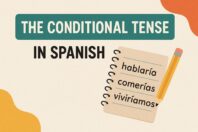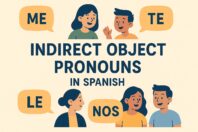What is Voseo in Spanish And How Can I Use It?

Get our free email course, Shortcut to Conversational.
Have conversations faster, understand people when they speak fast, and other tested tips to learn faster.
More infoVoseo in Spanish (or vos) is simply, an alternative way to express the second person singular, in addition to tú & usted.
That’s right – there are three ways to express “you” in Spanish.
For example:
- You must arrive earlier – Tú debes llegar más temprano
- You are a very good teacher – Usted es una profesora muy buena
- You are my best friend – Vos sos mi mejor amigo
Each form is used differently, depending on your relationship with the person you are speaking to, whereas in English, we use “you” regardless of whether we are talking to a group of people, our boss or our best friend.
Wait, Voseo vs Vos, what is the difference?
When we mention voseo or vos, we are talking about the same thing – voseo being the name of this concept, whereas vos is the actual personal pronoun used. Likewise, though it’s not as commonly heard, the use of tú is known as tuteo.
What is Voseo?
This refers to the use of the personal pronoun vos as a substitute for tú, when talking with friends and family (i.e informally).
It’s debatable which countries use vos, but in general, you’re more likely to hear vos than tú in Argentina and Chile, as well as some other parts of Latin America. It’s rare that you will hear it in Spain – instead you’ll hear tú and usted.
When to choose: tú, vos and usted?
The general rule is:
1) Tú and vos are informal pronouns that are interchangeable, and used with:
- Family and friends
- Peers
- Pets (for all animal lovers that enjoy talking to their pets)
2) Usted is formal, and used with:
- Elders
- Strangers or people you are not familiar with
- People held in high status (e.g your boss)
- Parents or in-laws: In some Latino families, it is a tradition to use this pronoun with parents, as a sign of respect
How is Voseo Conjugated?
For most tenses or moods, you can use personal pronoun vos with the tú conjugation of the verb.
However, there are three different instances that require a dedicated voseo conjugation.
Below, you can see each of these forms, along with the tú conjugation to see how it differs.
1) Simple present tense
- You can – Tú puedes – Vos podés
2) Imperative (affirmative)
- (You) come here! – Tú ven – Vos vení
3) Certain subjunctive forms
- When you sing everyone will hear – Cuando cantes todos oirán – Cuando vos cantés todos oirán
Like we said, the good news is that for all other tenses or moods, you can use vos with the tú conjugation.
(Ps, make sure to read our previous posts on the Imperative and subjunctive mood)
In the next section, we will cover the basic rules for conjugating voseo in the forms we mentioned.
1) Voseo: Simple Present Tense Conjugation
–AR Verbs: drop –ar and add –ás ending to the stem
| Verb ending | Verb | Conjugation | English |
| -AR | Viajar | viajás | You travel |
| Amar | amás | You love | |
| Nadar | nadás | You swim |
-ER Verbs: drop -er and add -és to the stem
| Verb ending | Verb | Conjugation | English |
| -ER | Beber | bebés | You drink |
| Correr | corrés | You run | |
| Leer | leés | You read |
-IR Verbs: drop -ir and add -ís to the stem
| Verb ending | Verb | Conjugation | English Equivalent |
| -IR | Vivir | vivís | You live |
| Dormir | dormís | You sleep | |
| sonreír | sonreís | You smile |
Remember – in the voseo form, the accent is in the second syllable, whereas in the tú form the first syllable is stronger. This implies that even the spelling is pretty similar, the pronunciation is notably different.
In most tenses, using vos as a substitute for tú does not require you to change the conjugation of the verb. Instead, you simply replace the preceding pronoun with vos.
For example:
| Tense | Tú | Vos | English Equivalent |
| Past Simple | (Tú) comiste ayer | (Vos) comiste ayer | You ate yesterday |
| Imperfect | (Tú) estudiabas mucho | (Vos) estudiabas mucho | You used to study a lot |
| Simple Future | (Tú) viajarás mañana | (Vos) viajarás mañana | You will travel tomorrow |
(as mentioned, the two exceptions to this rule are: simple present conjugation and imperative mood conjugation)
Irregular verbs conjugated in vos form have more of regular verbs conjugation, since the stem doesn’t always change as it does with the verb conjugated in tú.
Let’s see this comparison in the following chart.
| Verb | Tú | Vos |
| Jugar | jueg – as | jug – ás |
| Tener | tien – es | ten – és |
| Dormir | duerm – es | dorm – ís |
There are only three irregular verbs in the present tense, and these are:
- Ser (to be)
- Ir (to go)
- and Haber (to have).
Let’s see how they are conjugated in both the tú and vos form.
| Verb | Tú | Vos | English Equivalent |
| Ser | (Tú) eres | (Vos) sos | You are |
| Ir | (Tú) vas | (Vos) vas | You go to |
| Haber | (Tú) has | (Vos) has | You have |
2) Voseo: Imperative Conjugation (Affirmative)
To use voseo in the imperative (for commands or instructions), you need to remember the below rules:
- For -AR and -ER verbs, simply remove “r” from the infinitive ending and add an accent (tilde) to the final vowel of the verb.
- When conjugating -IR verbs, you replace -E with an -I ending
- Do not change the stem for irregular Verbs.
Don’t worry – this will make more sense once we see more examples.
-AR Verbs: Drop –ar and add -á ending to the stem
| Verb ending | Verb | Conjugation | English Equivalent |
| -AR | Viajar | viajá | Travel! |
| Amar | amá | Love! | |
| Nadar | nadá | Swim! |
-ER Verbs: drop -er and add -é to the stem
| Verb ending | Verb | Conjugation | English Equivalent |
| -ER | Beber | bebé | Drink! |
| Correr | corré | Run! | |
| Leer | leé | Read! |
-IR Verbs: drop -ir and add -í to the stem
| Verb ending | Verb | Conjugation | English Equivalent |
| -IR | Vivir | viví | Live! |
| Dormir | dormí | Sleep! | |
| sonreír | sonreí | Smile! |
Of course, there are a couple of exceptions to the rules mentioned.
The good news is that there are fewer irregular verbs in voseo imperative, compared to tuteo.
Common irregular verbs in tuteo like Ser (to be), Salir (to leave), or Poner (to put), are not irregular in voseo.
Let’s see:
| Verb | Tú | Vos |
| Ser | Sé | Sé |
| Salir | Sal | Salí |
| Poner | Pon | Poné |
There is only one irregular verb in imperative voseo, and that’s the verb ir (to go).
However, the imperative form of ir is not typically used in voseo, and instead, locals will use the verb andar (To go, To walk), which is regular.
Let’s see both of them conjugated side by side below.
| Verb | Tú | Vos |
| Ir | Ve | Id |
| Andar | Anda | Andá |
3) Voseo Subjunctive conjugation
To use the subjunctive mood with voseo, you simply use the personal pronoun vos + along with the tú conjugation of the verb.
Keep in mind that the last syllable should always be stressed.
The only subjunctive moods to use voseo are the: present subjunctive & imperfect subjunctive.
Present Subjunctive
| Verb ending | Verb | Conjugation |
| -AR | Viajar | viajés |
| Amar | amés | |
| Nadar | nadés |
| Verb ending | Verb | Conjugation |
| -ER | Beber | bebás |
| Correr | corrás | |
| Comer | comás |
| Verb ending | Verb | Conjugation |
| -IR | Vivir | vivás |
| Competir | compitás | |
| sonreír | sonríás |
Imperfect Subjunctive
There are two valid and accepted verb forms for the imperfect subjunctive conjugation.
| Verb ending | Verb | Conjugation |
| -AR | Viajar | viajaras/viajases |
| Amar | amaras/amases | |
| Nadar | nadaras/nadases |
| Verb ending | Verb | Conjugation |
| -ER | Beber | bebieras/bebieses |
| Correr | corrieras/corrieses | |
| Comer | comieras/comieses |
| Verb ending | Verb | Conjugation |
| -IR | Vivir | vivieras/vivieses |
| Competir | compitieras/compitieses | |
| sonreír | sonrieras/sonrieses |
Examples
- I don’t want you to eat that sandwich. It’s awful – No quiero que vos comás ese sándwich. Es horrible.
- We need you to go to the supermarket, we have no cereal – Necesitamos que vos vayás al supermercado, no tenemos cereal.
- I hope you attend tomorrow’s meeting – Espero que vos asistás a la reunión de mañana.
- If you live there you will understand – Si vos vivieses allí, vos entenderías
- If you travel, you will be in touch with other cultures – Si vos viajaras, vos estarías en contacto con otras culturas.
- If you love me as I love you, you will come – Si vos me amaras como yo te amo, vos vendrías
Different Types Of Voseo You’ll Hear
Voseo is a concept that has evolved throughout the years, meaning that the form you hear will often depend on which region you hear it in.
While I wouldn’t sweat it if you use it incorrectly, it’s always good to know how locals typically use this concept.
1. Voseo Dialectal Americano
This is the most important form of voseo to know.
Across Central and South America, locals use voseo when referring to a person with whom they have a bond of affection or intimacy with.
Within this type of voseo, there three different forms:
a) Voseo absoluto
The first combination uses vos pronoun + voseo verb conjugation:
| Subject (vos) + voseo conjugation + complement |
| Vos + podés + hacerlo |
Examples
- Do you want a sandwich? – ¿Vos querés un sándwich?
- You are a terrible student – Vos sos un estudiante pésimo
- You have a nice Colombian accent – Vos tenés un bonito acento colombiano
b) Voseo pronominal
The second way, tú pronoun must be paired with voseo verb form
| Subject (tú) + voseo verb form + complement |
| Tú + cocinás + muy bien |
Examples
- Do you love your family? – ¿Tú amás a tu familia?
- You want to go to the party but I don’t – Tú querés ir a la fiesta pero yo no
- You cry all the time – Tú llorás todo el tiempo
c) Voseo verbal
In this combination, vos pronoun will go along with tú conjugation
| Subject (vos) + tú verb form + complement |
| Vos + te levantas + muy temprano |
Examples
- You make a cake every two weeks – Vos haces un pastel cada dos semanas
- Do you use a PC or a laptop? – ¿Vos usas una PC o una laptop
- You work in a big company – Vos trabajas en una compañía grande
The main difference in when to use one over the others will depend on the region where you are and their culture.
For example, the voseo pronominal is commonly used in Argentina but in Uruguay, you will hear people using the pronominal form and the verbal form.
Our best advice, in this case, is to mimic what you learn local or native speakers in the region say.
Once again, we must reiterate that you will be understood regardless of whatever form you use.
2. Voseo Reverencial (or Español)
It is used when a person refers respectfully or with reverence to another in the 2nd person singular. This type of voseo is practically outdated nowadays. It is only found in historical novels or ancient literature.
It is formed by using the vos pronoun, plus the verb in the second person plural (vosotros).
Examples
- You are the King of Spain – Vos sois el rey de España
- Whatever you say, it will be good – Lo que vos digáis, será bueno
- You have the last word – Vos tenéis la última palabra
Vos vs Vosotros
Vos should not be confused with the pronoun vosotros (as).
Here are their main differences:
a) In grammatical terms, vos is an informal second person singular pronoun used in many Latin American countries. Vosotros is an informal second person plural pronoun only used in Spain.
b) As mentioned before, the use of vos is a characteristic of many areas from Central and South America, but it is almost non-existent in Spain. Whereas vosotros (as) is only used in Spain.



